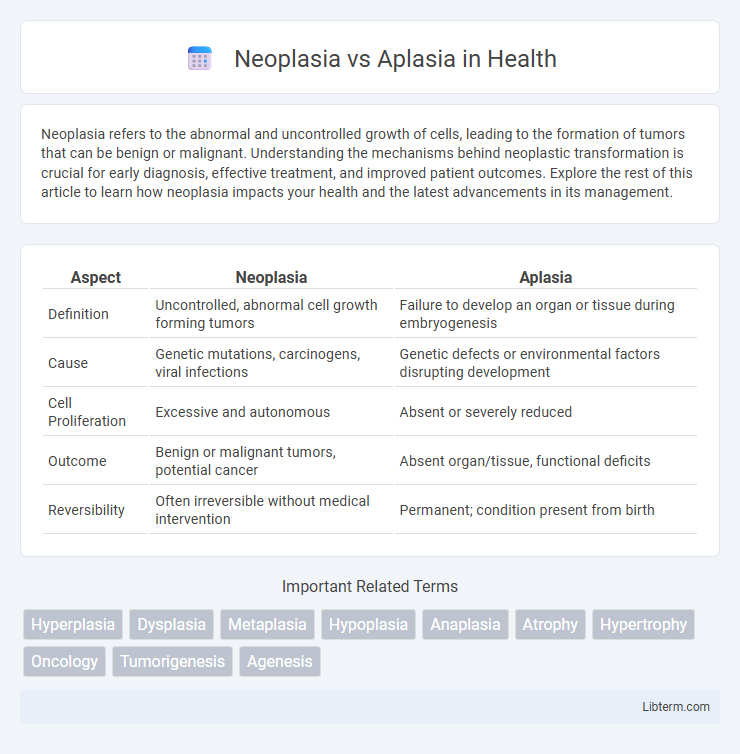Neoplasia refers to the abnormal and uncontrolled growth of cells, leading to the formation of tumors that can be benign or malignant. Understanding the mechanisms behind neoplastic transformation is crucial for early diagnosis, effective treatment, and improved patient outcomes. Explore the rest of this article to learn how neoplasia impacts your health and the latest advancements in its management.
Table of Comparison
| Aspect | Neoplasia | Aplasia |
|---|---|---|
| Definition | Uncontrolled, abnormal cell growth forming tumors | Failure to develop an organ or tissue during embryogenesis |
| Cause | Genetic mutations, carcinogens, viral infections | Genetic defects or environmental factors disrupting development |
| Cell Proliferation | Excessive and autonomous | Absent or severely reduced |
| Outcome | Benign or malignant tumors, potential cancer | Absent organ/tissue, functional deficits |
| Reversibility | Often irreversible without medical intervention | Permanent; condition present from birth |
Introduction to Neoplasia and Aplasia
Neoplasia refers to the abnormal and uncontrolled growth of cells forming a neoplasm or tumor, which can be benign or malignant, disrupting normal tissue function. Aplasia is the failure of an organ or tissue to develop or function, characterized by the absence or incomplete formation of cells during embryonic growth. Understanding the cellular mechanisms and genetic factors underlying neoplasia and aplasia is crucial for diagnosing and treating various pathological conditions.
Defining Neoplasia: Key Concepts
Neoplasia refers to the abnormal and uncontrolled proliferation of cells forming a neoplasm or tumor, which can be benign or malignant. Unlike aplasia, where there is a failure in tissue or organ development due to the absence of cell proliferation, neoplasia involves excessive cell growth independent of normal regulatory mechanisms. Key concepts in neoplasia include clonal expansion, genetic mutations driving uncontrolled cell division, and potential invasion or metastasis in malignant forms.
Understanding Aplasia: Basic Overview
Aplasia refers to the complete absence of an organ or tissue due to the failure of its development during embryogenesis, distinguishing it from neoplasia, which involves abnormal and uncontrolled cell growth forming tumors. This congenital condition results in missing or severely underdeveloped structures, often detected through imaging or clinical evaluation. Understanding aplasia is crucial for diagnosing developmental abnormalities and differentiating them from neoplastic processes.
Cellular Mechanisms in Neoplasia
Neoplasia involves uncontrolled cellular proliferation due to genetic mutations affecting oncogenes and tumor suppressor genes, leading to abnormal cell growth and division. Key cellular mechanisms include evasion of apoptosis, sustained angiogenesis, and altered cell cycle regulation, driving tumor development and progression. In contrast, aplasia refers to the absence or failure of tissue formation, often resulting from developmental defects without excessive cell proliferation.
Cellular Mechanisms in Aplasia
Aplasia is characterized by the failure of organ or tissue development due to the absence or severe reduction of precursor cells, resulting from disruptions in cellular proliferation and differentiation pathways. In contrast to neoplasia, which involves uncontrolled and autonomous cell growth, aplasia involves defective signaling in stem cell niches and a failure to initiate or maintain cell cycle progression. Molecular mechanisms such as impaired growth factor signaling, apoptosis dysregulation, and epigenetic modifications contribute to the arrested development seen in aplasia.
Causes and Risk Factors of Neoplasia
Neoplasia arises from genetic mutations caused by factors such as carcinogens, chronic inflammation, and viral infections like HPV, which disrupt normal cellular growth control. Risk factors include exposure to tobacco smoke, radiation, certain chemicals, and inherited genetic predispositions that increase susceptibility to uncontrolled cell proliferation. In contrast, aplasia results from developmental failure or damage to stem cells, typically without the influence of mutagenic agents driving neoplastic transformation.
Causes and Risk Factors of Aplasia
Aplasia is primarily caused by genetic mutations, viral infections, and exposure to toxic chemicals or radiation, which impair stem cell development in the bone marrow. Risk factors include congenital disorders like Fanconi anemia, autoimmune diseases, certain medications such as chemotherapy agents, and environmental toxins. Unlike neoplasia, which involves uncontrolled cellular proliferation, aplasia results from defective or absent cell formation, leading to deficient tissue or organ development.
Clinical Manifestations: Neoplasia vs Aplasia
Neoplasia presents with abnormal tissue growth, appearing as tumors that can be benign or malignant, often causing symptoms like pain, swelling, or functional impairment depending on the tumor location. Aplasia is characterized by the complete absence or failure of an organ or tissue to develop, leading to clinical manifestations related to the loss of function, such as anemia in bone marrow aplasia or immunodeficiency in thymic aplasia. Clinical diagnosis involves imaging and histopathological analysis to differentiate uncontrolled proliferative masses in neoplasia from absent or underdeveloped tissues in aplasia.
Diagnostic Approaches for Neoplasia and Aplasia
Diagnostic approaches for neoplasia primarily involve imaging techniques such as MRI, CT scans, and PET scans to identify abnormal growths, supplemented by biopsy and histopathological examination to determine malignancy and tumor grade. In contrast, aplasia diagnosis relies heavily on bone marrow aspiration and biopsy to assess cellularity and the lack of progenitor cells, combined with complete blood count (CBC) tests to evaluate the extent of cytopenias. Molecular genetic testing and immunophenotyping also play crucial roles in differentiating aplastic conditions from neoplastic disorders, ensuring accurate diagnosis and appropriate treatment planning.
Treatment Strategies and Prognosis
Treatment strategies for neoplasia primarily involve surgical excision, chemotherapy, radiation therapy, or targeted molecular treatments, depending on tumor type and stage. Aplasia management focuses on supportive care, stem cell transplantation, or growth factor therapies to stimulate bone marrow recovery or organ function. Prognosis in neoplasia varies widely based on malignancy grade and response to treatment, while aplasia prognosis depends on the severity and the success of restoring normal tissue function.
Neoplasia Infographic

 libterm.com
libterm.com